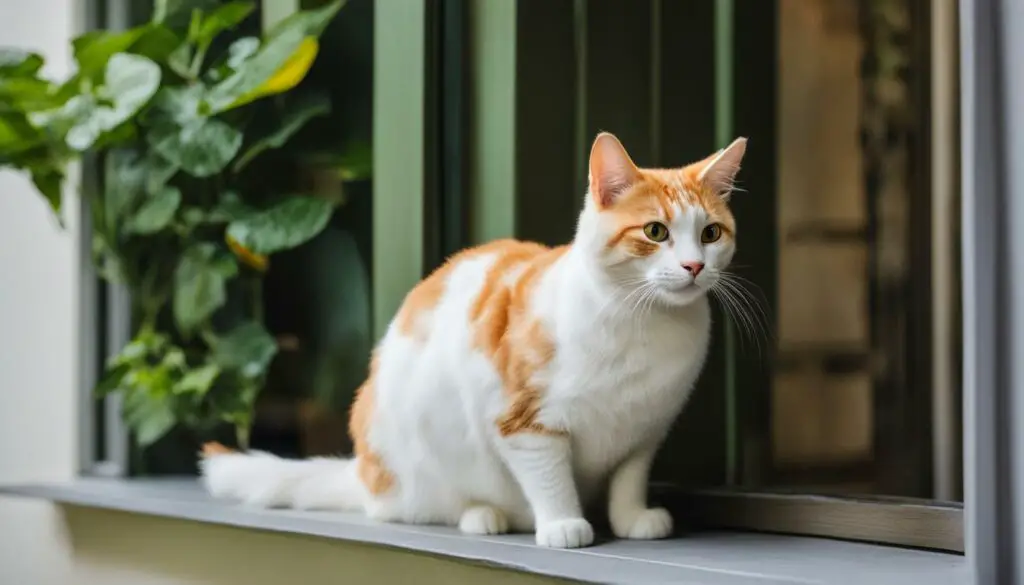I’ve always been fascinated by feline behaviors and the unique ways cats communicate with us. One behavior that often captures my attention is when my cat winks at me. It’s an adorable and mysterious gesture that leaves me wondering what it means. So, I decided to delve deeper into this phenomenon and gather expert insights to address this common query – why do cats wink at us?
Firstly, it’s important to note that winking can be both deliberate and involuntary. Cats may wink at us intentionally, as a way of showing affection and trust. They may also wink involuntarily as a reflexive action to protect their eyes. Understanding the different scenarios in which cats wink can provide valuable insights into their emotions and overall well-being.
In this article, we will explore the significance of cat winking, the difference between deliberate and involuntary winking, and how we can interpret these feline behaviors. From the language of feline communication to the various reasons behind cat winking, we’ll uncover the fascinating world of cats and their eye movements.
So join me on this journey as we uncover the fun facts and expert insights behind cat winking and address the common queries surrounding this adorable behavior.
Key Takeaways:
- Cat winking can be a sign of affection and trust.
- Winking can also be an involuntary reflex to protect the eyes.
- Cats communicate through various non-verbal cues, including eye movements.
- Understanding cat eye positions can help interpret their emotions and intentions.
- Regular observation of your cat’s eye health is important for detecting underlying medical issues.
Cat Winking: Deliberate or Involuntary?
When it comes to cat winking, it can be both deliberate and involuntary. Cats have the ability to wink by shutting one eye and then opening it again. If a cat winks at you, it is a deliberate action that often involves direct eye contact. This type of wink is usually a sign of affection and trust. On the other hand, cats can also wink involuntarily as a reflexive action to protect their eyes. Involuntary winking can occur when a cat closes its eyes quickly to shield the eyeballs from potential harm.
The speed and motion of the wink can provide insights into whether it is intentional or related to an underlying issue. Intentional winking tends to be slower and more deliberate, while involuntary winking can be faster and abrupt. It’s important to observe your cat’s behavior and body language to determine the context of the wink.
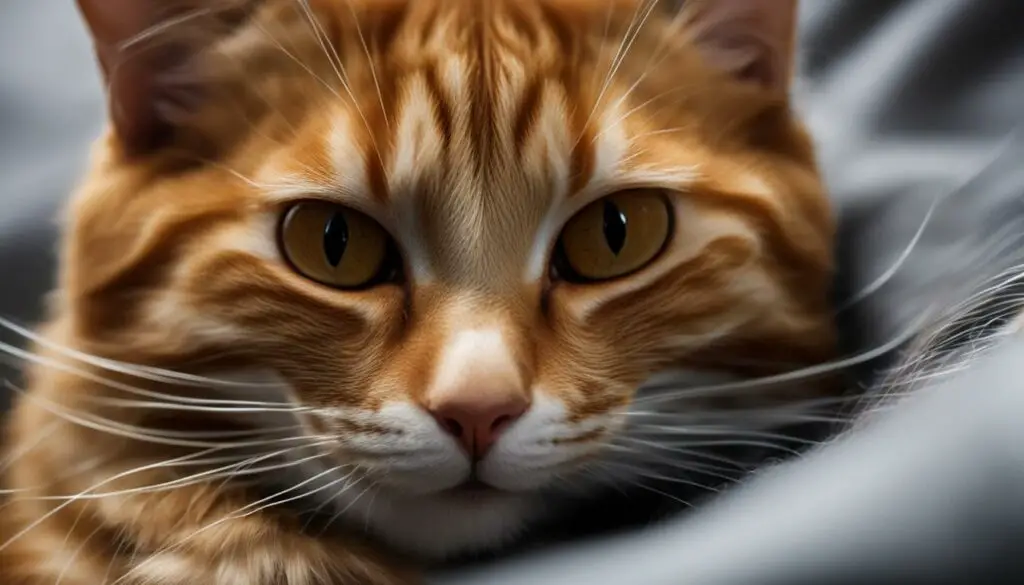
Understanding whether a cat’s wink is deliberate or involuntary can help decipher their intentions and emotions. Deliberate winking often signifies affection and trust, while involuntary winking may indicate a protective reflex or potential eye health concerns. As a cat owner, it’s crucial to pay attention to these subtle communication signals to promote a deeper understanding and connection with your feline companion.
Cat Blinking: A Sign of Love
When your cat blinks at you, it’s not just a random action – it’s a sign of affection. Blinking is a form of communication that cats use to express their fondness for someone. Slow blinking, in particular, is a gesture that signifies trust and comfort. It’s like a “kitty kiss” that shows your cat feels safe and secure in your presence.
So, what does a slow blink look like? It’s when your cat closes their eyes halfway and then opens them again. It’s a deliberate and intentional act. When your cat gives you a slow blink, they are telling you that they like being around you and that they trust you. It’s their way of saying, “I love you.”
But why do cats use blinking as a sign of affection? It’s believed that cats have learned to blink slowly as a way to communicate with humans. In the wild, maintaining eye contact for an extended period can be seen as a threat or aggression. By blinking slowly, cats break the stare and convey a message of non-aggression. So when your cat gives you a slow blink, they are not only expressing their love for you but also showing that they mean no harm.
Table: Cat Blinking – Slow Blink vs. Normal Blink
| Slow Blink | Normal Blink |
|---|---|
| Half-closed eyes | Both eyes fully closed |
| Deliberate and intentional | Reflexive and involuntary |
| Sign of affection and trust | Resting or moisturizing the eyes |
Next time your cat gives you a slow blink, be sure to return the gesture. Slowly close your eyes and then open them again. This reciprocal act can strengthen the bond between you and your feline companion. Remember, cat blinking is a beautiful form of communication that allows you to connect on a deeper level with your furry friend.
Reasons for Cat Winking
Cat winking can have various reasons, ranging from showing love and affection to indicating a medical problem. Winking is often a sign of love and affection towards their owners, a way for cats to communicate that they feel safe and secure in their presence. It can also be a way for cats to communicate with each other, indicating trust and camaraderie.
However, it’s important to note that frequent winking, especially when accompanied by other signs of illness, may indicate a medical problem. Involuntary winking can be a symptom of eye infections or other eye issues that require veterinary attention. It’s crucial to monitor your cat’s behavior and seek professional help if you notice any persistent or concerning winking.
By understanding the reasons behind cat winking, you can better interpret and respond to your cat’s behavior, strengthening the bond between you and your feline companion.
Medical Issues and Eye Winking
Involuntary winking in cats can be a sign of various medical issues that require attention. It’s important to recognize the potential underlying health problems that may cause frequent winking or blinking in cats. One common medical issue associated with eye winking is conjunctivitis, an eye infection that causes redness, discharge, and swelling of the conjunctiva. This condition can be caused by bacterial or viral infections, allergies, or irritants.
Allergic reactions can also lead to involuntary winking in cats. Environmental allergens, such as pollen or dust mites, can cause irritation in the eyes, resulting in excessive blinking or winking. Cats may also develop corneal ulcers, which are open sores on the cornea that can cause discomfort and lead to winking or squinting. Corneal ulcers can be caused by injuries, scratches, or infections.
Other serious eye conditions that may cause winking in cats include cataracts and glaucoma. Cataracts are characterized by the clouding of the eye lens, which reduces vision and can lead to winking or blinking. Glaucoma, on the other hand, is a condition that causes increased pressure within the eye and can result in pain, vision loss, and involuntary eye movements, including winking or blinking.
If your cat is winking frequently or showing signs of discomfort, such as redness, discharge, or squinting, it’s crucial to seek veterinary care. A thorough examination by a veterinarian can help determine the underlying cause of the winking and ensure appropriate treatment is provided to alleviate any discomfort or address any medical conditions.
| Medical Issues | Causes |
|---|---|
| Conjunctivitis | Bacterial or viral infections, allergies, irritants |
| Allergic reactions | Environmental allergens |
| Corneal ulcers | Injuries, scratches, infections |
| Cataracts | Clouding of the eye lens |
| Glaucoma | Increased eye pressure |
Table: Common Medical Issues and Causes of Eye Winking in Cats
The Third Eyelid and Eye Positions
Cats have a fascinating and unique feature known as the third eyelid, formally called the nictitating membrane. This thin, translucent membrane is located in the inner corner of the eye and serves to protect and moisten the eye. It can move across the eye’s surface, covering it partially or fully when needed. The third eyelid is not always visible and may be an indication of underlying health issues when it becomes more prominent.
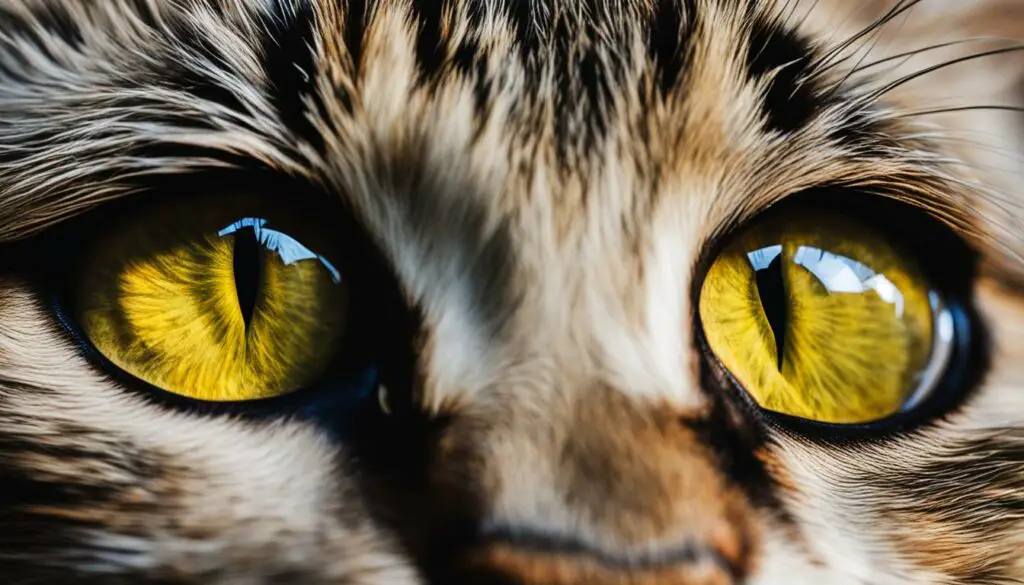
When it comes to eye positions, cats have a range of expressions that communicate different emotions. Dilated pupils, where the pupils appear larger than usual, can indicate fear or excitement. On the other hand, constricted pupils, where the pupils appear smaller, can signify contentment or irritation. Semi-closed eyes, where the cat appears to be squinting, indicate a state of relaxation and comfort. These eye positions provide valuable insights into a cat’s mood and can help us better understand their emotions.
Direct eye contact without blinking can be seen as a challenge or threat in cat language. It’s important to respect a cat’s personal space and not force direct eye contact if they are avoiding it. Cats communicate with one another through subtle signals, including eye positions, and understanding these cues can help us interact with them more effectively.
The Significance of Cat Winking
When a cat winks at you, it’s not just a random action. Cat winking holds significant meaning and can indicate feelings of trust, love, and comfort. This non-verbal communication is their way of expressing affection and forming bonds with their human companions. Understanding the significance of cat winking can help strengthen the relationship between cats and humans.
Winking is a gesture that signifies trust. When a cat winks at you, it’s a sign that they feel secure in your presence. The act of closing one eye and then opening it again demonstrates their comfort and relaxation around you. It’s their way of saying, “I trust you.” This behavior is particularly meaningful since cats are known to be cautious creatures who are selective in choosing the people they feel safe with.
Cat winking also symbolizes love. When a cat gives you a wink, it’s a way for them to show their affection towards you. They feel a deep connection with you and want to express it through this subtle gesture. It’s their way of saying, “I care about you.” Recognizing this sign of love can help deepen the bond between you and your furry friend.
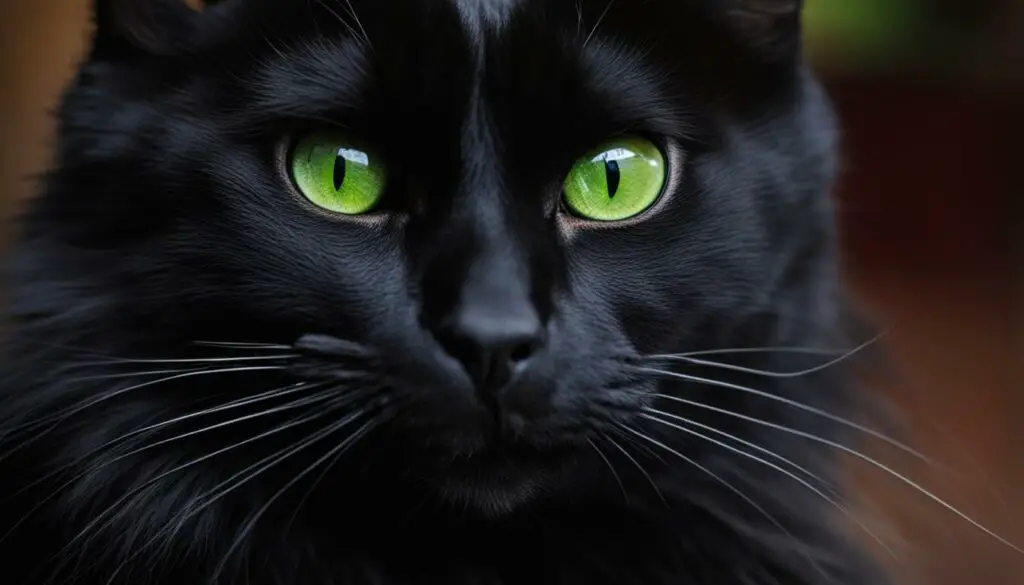
In addition to trust and love, cat winking represents a sense of comfort. Cats feel relaxed and at ease when they wink at you. It indicates that they feel safe and content in your presence. By reciprocating this gesture with a gentle blink back, you can reinforce their comfort and create a sense of calmness between you and your feline companion. It’s a beautiful way to connect on a deeper level and build a strong relationship based on trust and understanding.
The Wink vs. Blink Debate
When it comes to cat communication, the debate between winking and blinking often arises. While both actions involve the closing and reopening of the eyes, their meanings and intentions can differ.
Winking is typically seen as an intentional gesture, a deliberate action by a cat to convey love, trust, or affection. This intentional wink is usually directed at a specific person and may be accompanied by prolonged eye contact. It’s a way for cats to express their fondness and form a deeper bond.
Blinking, on the other hand, can be both deliberate and reflexive. Cats may blink to break a stare or to communicate comfort and relaxation. The slow, deliberate blink is often referred to as a “kitty kiss” and is a sign that the cat feels safe and secure in the presence of the person. Reflexive blinking, on the other hand, occurs when a cat instinctively closes its eyes to protect its sensitive eyeballs.
“Understanding the difference between winking and blinking is important for interpreting a cat’s communication signals. While winking is a deliberate expression of affection, blinking can convey a range of messages, from contentment to the need for a break in eye contact.”
Both winking and blinking are part of cats’ unique communication signals. By observing their behavior and paying attention to the context in which these actions occur, cat owners can gain a better understanding of their feline companions.
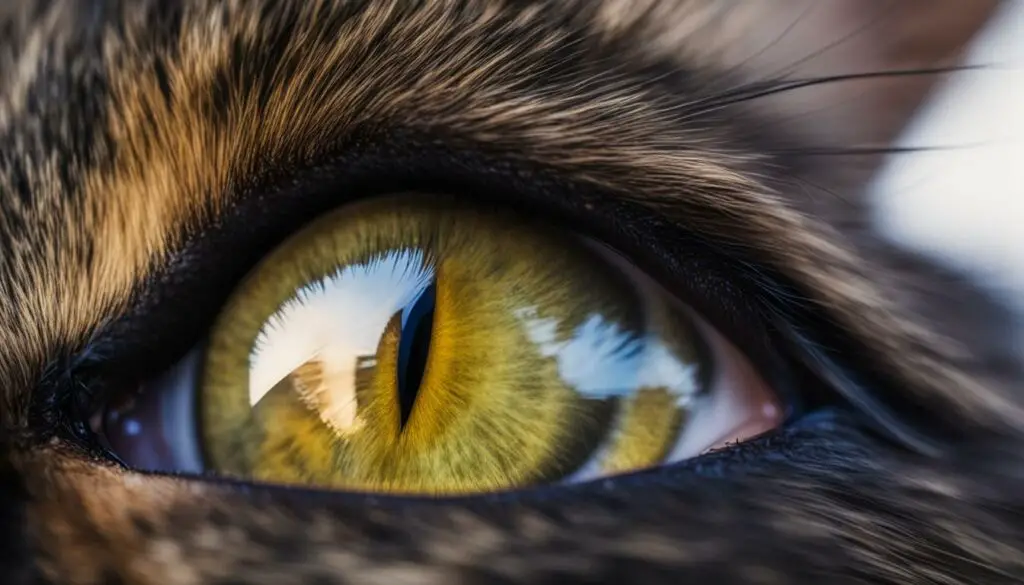
| Winking | Blinking | |
|---|---|---|
| Meaning | Intentional gesture, conveying love, trust, and affection | Can be deliberate or reflexive, signifying comfort or the need for a break in eye contact |
| Eye Contact | Often accompanied by prolonged eye contact | May be accompanied by a slow, deliberate blink |
| Communication | Expresses bonding and deeper affection | Indicates comfort, relaxation, or the need for a break in eye contact |
Winking in Kittens
Winking behavior is not limited to adult cats; kittens can also exhibit this intriguing behavior. In kittens, winking with one eye can indicate feelings of sorrow or depression. It serves as a way for them to express that their emotions have been hurt. Kittens are sensitive creatures, and their winking can be a form of communication, conveying their emotional state and seeking comfort.
Just like in adult cats, winking in kittens holds significance as a communication signal. It is crucial for cat owners to pay attention to these non-verbal cues and respond accordingly. By providing emotional support and understanding the meaning behind their winking, we can help kittens feel safe, loved, and secure.
Understanding this behavior can help provide emotional support to young kittens.
Winking in kittens is a reminder of their vulnerability and the importance of nurturing their emotional well-being. By observing and deciphering their communication signals, we can build a stronger connection with our feline companions from an early age.
Table: Comparing Winking Behavior in Kittens and Adult Cats
| Kittens | Adult Cats | |
|---|---|---|
| Age Range | Up to 6 months old | 6 months and older |
| Emotional Meaning | Sorrow or depression | Affection or communication |
| Communication Signal | Expression of hurt feelings | Expression of love or trust |
| Response | Provide emotional support and comfort | Respond with affection and understanding |
Note: The table above compares the winking behavior in kittens and adult cats, highlighting their age range, emotional meaning, communication signal, and recommended response.
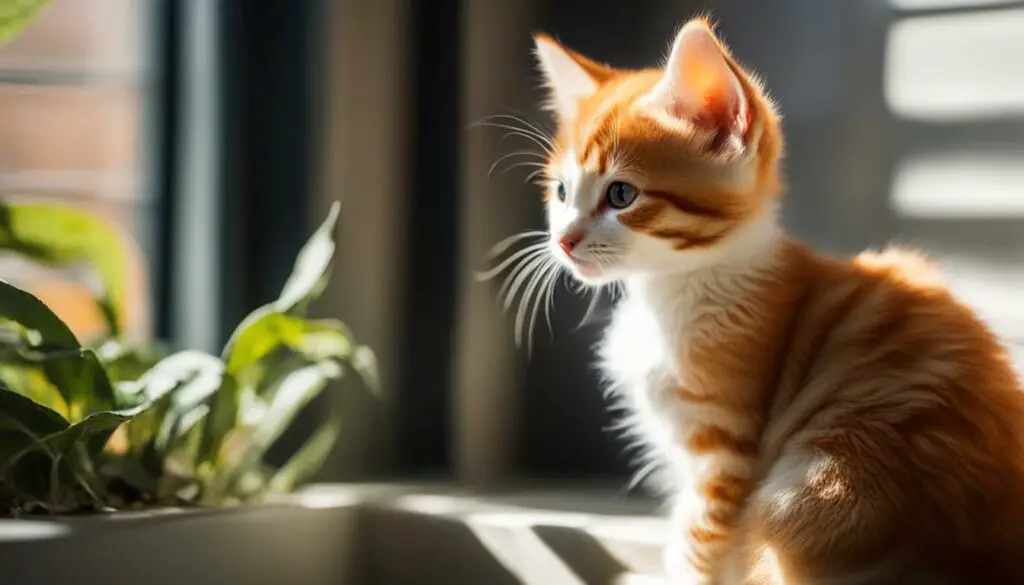
Addressing Common Queries and Misconceptions
When it comes to cats winking, there are often common queries and misconceptions that arise. Some people may mistakenly believe that a cat winking is a sign of aggression or misbehavior. However, the truth is that cat winking is usually a positive gesture with various meanings.
One common misconception is that cat winking is a deliberate action to annoy or provoke. In reality, winking is often a sign of affection, trust, and comfort. It’s a way for cats to communicate their feelings towards their owners and form a bond. So, the next time your cat gives you a wink, take it as a sign of their love and appreciation!
Another query that arises is whether frequent winking is a cause for concern. While occasional winking is completely normal, frequent winking, especially when accompanied by other signs of illness, may indicate an underlying medical issue. Involuntary winking can be a symptom of eye infections or other eye problems that require attention from a veterinarian.
| Common Misconceptions | Reality |
|---|---|
| Cat winking is a sign of aggression or misbehavior. | Cat winking is often a gesture of affection and trust. |
| Winking behavior should be discouraged or corrected. | Winking behavior is a natural and positive form of communication. |
| Frequent winking is not a cause for concern. | Frequent winking, especially when accompanied by other signs of illness, may indicate a medical issue. |
By addressing these common queries and misconceptions, we can better understand and appreciate the significance of cat winking. It’s important to educate cat owners about the true meaning behind this behavior and dispel any misunderstandings. So, the next time your feline friend winks at you, remember that it’s their way of expressing love and trust!
“Cat winking is often a gesture of affection and trust.”
The Importance of Observing Eye Health
Observing your cat’s eye health is crucial for maintaining their overall well-being. By recognizing and addressing signs of illness in their eyes, you can ensure your furry friend stays healthy and happy. Regular observation and seeking veterinary care when necessary are key factors in providing the best possible care for your cat.
Recognizing signs of illness in your cat’s eyes can prevent potential complications and discomfort. Keep an eye out for symptoms such as frequent winking or blinking, redness, discharge, swelling, or changes in the appearance of the eye. These can be indications of underlying issues that require immediate attention from a qualified veterinarian.
Seeking veterinary care promptly is essential when it comes to eye health. Your veterinarian can examine your cat’s eyes thoroughly and provide a proper diagnosis. They may recommend treatments such as eye drops or ointments to alleviate any discomfort or prescribe medications to treat eye infections or other underlying conditions.
Table: Common Signs of Eye Problems in Cats
| Signs | Possible Causes |
|---|---|
| Frequent winking or blinking | Eye infection, conjunctivitis, allergic reaction |
| Redness, discharge, or swelling | Eye infection, injury, inflammation |
| Cloudiness or changes in eye appearance | Cataract, corneal ulcer, glaucoma |
| Excessive tearing or dryness | Blocked tear ducts, dry eye syndrome |
Remember, as a responsible cat owner, you play a crucial role in maintaining the health and happiness of your feline companion. By observing their eye health and seeking veterinary care when needed, you can ensure they receive the necessary treatment and enjoy a life free from discomfort or complications related to eye problems. Stay vigilant, and your cat will thank you with their bright, healthy eyes!
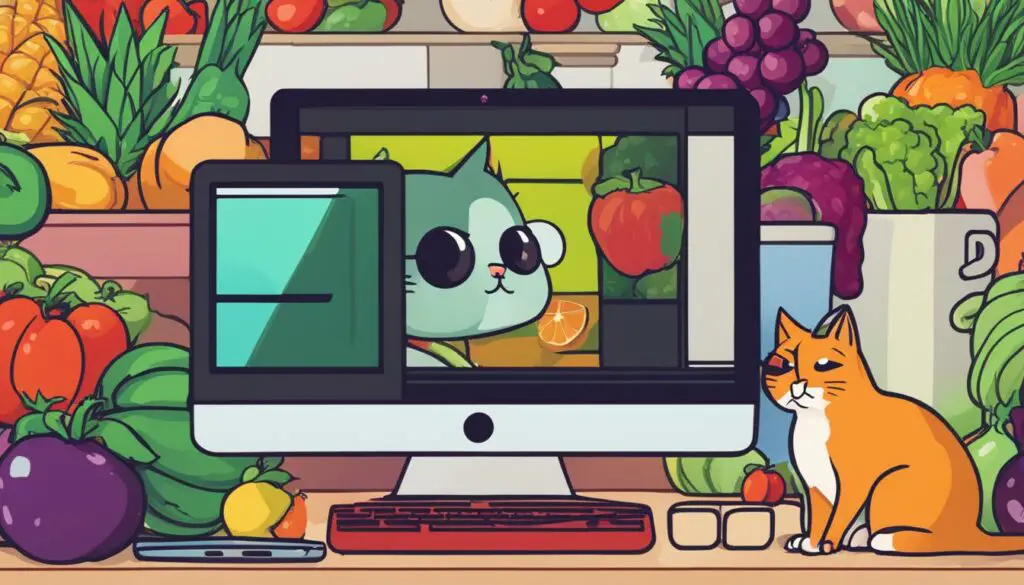
Feline Communication: Understanding Non-Verbal Cues and Body Language
When it comes to communication, cats have their own unique language that goes beyond meows and purrs. Understanding feline communication is key to strengthening the bond between cats and their human companions. Cats rely heavily on non-verbal cues and body language to express their emotions, intentions, and needs. By observing and interpreting these signals, we can better respond to our feline friends and provide the care and environment they require.
Feline communication through non-verbal cues includes various behaviors, such as winking and blinking. Winking is an intentional action that cats may use to convey love and trust. It’s their way of saying, “I feel safe and comfortable with you.” On the other hand, blinking is a slow, deliberate movement that signifies affection and contentment. When a cat blinks at you, it’s like a kitty kiss, a sign that they appreciate your presence.
Body language also plays a crucial role in feline communication. Cats use their body postures, ear positions, and tail movements to express their emotions. For example, a relaxed and confident cat will have an upright tail, while a fearful or anxious cat may tuck its tail between its legs. Understanding these subtle cues can help us gauge a cat’s mood and respond accordingly, ensuring their well-being and happiness.
| Non-Verbal Cues | Meaning |
|---|---|
| Winking | Sign of love and trust |
| Blinking | Expression of affection and contentment |
| Slow tail swish | Relaxed and content |
| Puffed-up tail | Fearful or aggressive |
| Ear forward | Attentive and curious |
Understanding feline communication is a journey that deepens our connection with our feline companions. By paying attention to their non-verbal cues and body language, we can better understand their emotions, needs, and desires. It’s a language that goes beyond words and enables us to create a harmonious and fulfilling bond with our feline friends.
So the next time your cat winks or blinks at you, remember that it’s their way of saying, “I trust you, I love you.” Embrace their non-verbal communication and respond with love and care. Your feline companion will appreciate the effort, and your relationship will flourish.
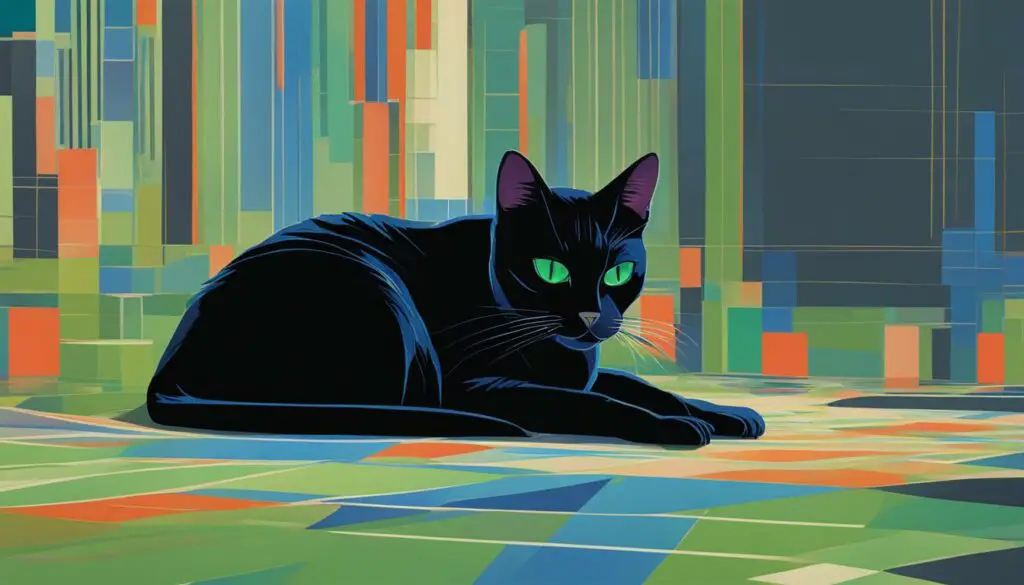
Interpreting Cat Eye Positions
When it comes to understanding our feline companions, interpreting their eye positions can provide valuable insights into their emotions and intentions. Cats utilize their eyes as a crucial form of non-verbal communication, and by paying attention to their eye movements, we can better respond to their needs and create a harmonious environment for them.
Dilated pupils in cats can indicate a range of emotions, from fear to excitement. When a cat’s pupils are dilated, it suggests that they are experiencing an intense emotional state. On the other hand, constricted pupils or semi-closed eyes are signs of relaxation and contentment. These eye positions often accompany feelings of comfort and trust, indicating that your feline friend is at ease in their surroundings.
Direct eye contact without blinking can be seen as a challenge or threat in cat language.
It’s important to note that direct eye contact without blinking can be perceived as a challenge or threat in the world of feline communication. Cats consider unbroken eye contact as an act of dominance, and it can make them feel uneasy or defensive. To maintain a positive connection with your cat, it’s best to avoid extended periods of direct eye contact without blinking.
| Eye Position | Meaning |
|---|---|
| Dilated pupils | Fear or excitement |
| Constricted pupils | Relaxation and contentment |
| Semi-closed eyes | Comfort and trust |
By observing and interpreting these eye positions, we can better understand what our cats are trying to communicate. Whether it’s recognizing their need for space or providing them with comfort, our understanding of cat eye positions can foster a deeper connection with our feline companions.
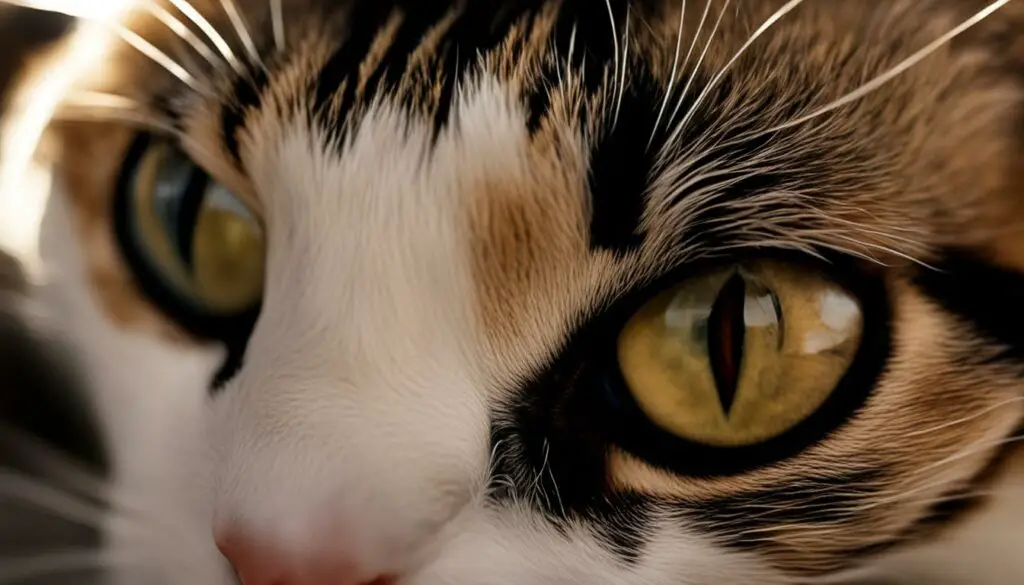
The Joy of Kitty Kisses
Cats have a unique way of expressing their love and affection, and one of the most delightful gestures is the slow blink, also known as a “kitty kiss.” When a cat gives you a slow blink, it’s their way of saying “I love you” and showing that they feel safe and secure in your presence. This gentle closing and opening of their eyes is a sign of trust and contentment.
Slow blinking is a feline behavior that is often associated with positive emotions. It’s their way of saying that they feel comfortable and at ease with you. By reciprocating the slow blink, you can strengthen the bond with your cat and create a sense of mutual understanding. Try blinking slowly at your cat and see how they respond. It’s a special moment of connection that can bring you closer together.
So, the next time your cat gives you a slow blink, know that it’s a token of their affection. Cherish these kitty kisses and embrace the joy they bring to your life. The language of cats may be different from ours, but the love they express is universal.
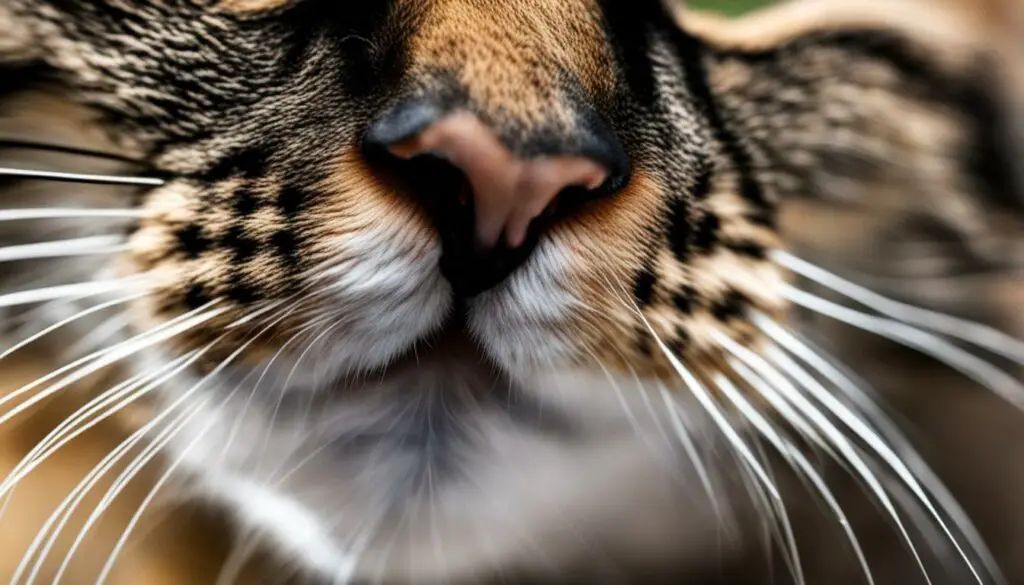
| Benefits of Kitty Kisses | How to Respond |
|---|---|
| Strengthens the bond between you and your cat | Reciprocate the slow blink to show your love |
| Creates a sense of trust and security | Use a gentle and relaxed tone of voice |
| Enhances the emotional well-being of your cat | Offer gentle strokes and cuddles |
The Power of Slow Blinking
“When my cat gives me a slow blink, it instantly melts my heart. It’s like our little secret language of love. I always make sure to give her a slow blink back to let her know how much I care.”
Enhancing the Feline-Human Connection
In order to strengthen the bond between cats and humans, it is crucial to understand and respond to their behaviors and communication signals. By observing and interpreting their actions, we can deepen our connection with our feline companions and provide them with the love and care they need.
Cat behavior can be complex, but by paying attention to their body language, we can gain valuable insights into their emotions and intentions. For example, when a cat winks or blinks at us, it is often a sign of trust and affection. By reciprocating with a slow blink of our own, we can let our cats know that we feel the same way, enhancing the sense of mutual understanding and love.
Understanding cat behavior also involves recognizing the significance of eye health. Regularly monitoring our cats’ eyes and seeking veterinary care when necessary can help prevent and address any underlying issues that may be causing discomfort or affecting their vision. By taking proactive steps to ensure their eye health, we can contribute to their overall well-being and strengthen the bond between us.
In summary, enhancing the feline-human connection requires a combination of understanding cat behavior, responding to their non-verbal cues, and prioritizing their eye health. By doing so, we can build trust, provide comfort, and create a deep and fulfilling relationship with our beloved feline friends.
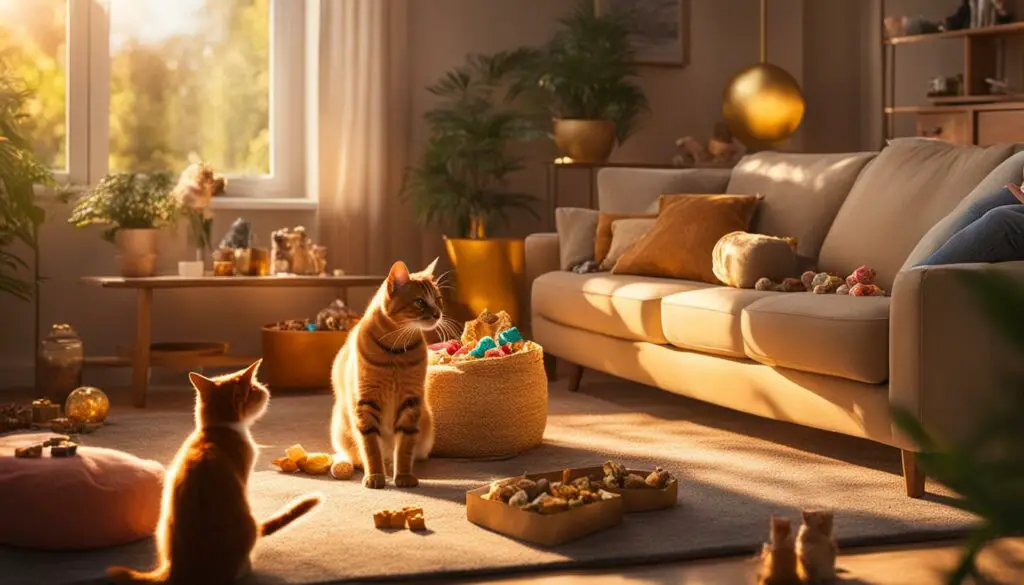
| Benefit | How to Achieve |
|---|---|
| Build trust | Respond to their non-verbal cues, such as winking and blinking, with reciprocation and affection |
| Provide comfort | Pay attention to their body language and create a safe and loving environment |
| Prioritize eye health | Regularly monitor their eyes and seek veterinary care when necessary |
Conclusion
In conclusion, cat winking is a fascinating behavior that cats use to communicate with humans and other cats. It can signify love, trust, and comfort, and is often a positive gesture. However, it’s essential to be aware of the frequency and context of winking, as frequent winking or blinking, especially when accompanied by other signs of illness, may indicate a medical problem that requires veterinary attention.
Understanding the language of feline communication, including interpreting eye positions and recognizing other non-verbal cues, can help strengthen the bond between cats and their human companions. By responding appropriately to their behaviors, such as reciprocating kitty kisses with slow blinking, cat owners can enhance the feline-human connection and create a sense of trust and comfort.
Observing your cat’s eye health is also crucial for maintaining their overall well-being. Regularly monitoring their eyes and seeking veterinary care when necessary can ensure any underlying eye issues or infections are detected and addressed promptly.
In summary, by understanding the significance of cat winking, observing their eye health, and interpreting their non-verbal cues, cat owners can deepen their bond with their feline companions and provide them with the love, care, and understanding they deserve.
FAQ
Can cat winking be deliberate or involuntary?
Cat winking can be either deliberate or involuntary, depending on the situation. Some winks are intentional and a sign of affection, while others are reflexive actions to protect the eyes.
What does cat blinking indicate?
Cat blinking is often a sign of love and affection. Slow blinking is a way for cats to communicate that they feel safe and secure in someone’s presence.
Why do cats wink?
Cats may wink as a sign of love and affection towards their owners or as a way to communicate with other cats. It can also indicate trust and comfort.
Can cat winking be a sign of a medical problem?
Yes, frequent winking, especially when accompanied by other signs of illness, may indicate a medical issue. It is important to consult a veterinarian if your cat is winking frequently and showing signs of discomfort.
What medical issues can cause cats to wink?
Cats may wink due to various medical issues, including eye infections, allergic reactions, corneal ulcers, cataracts, and glaucoma. These conditions require veterinary attention.
What is the significance of a cat’s third eyelid and eye positions?
Cats have a third eyelid called the nictitating membrane, which helps protect their eyes. Different eye positions in cats convey different meanings, such as fear, contentment, relaxation, or a challenge.
Why is cat winking significant?
Cat winking is significant as it indicates trust, love, and comfort. When a cat winks at you, it’s a sign that they feel safe and secure in your presence.
What is the difference between a wink and a blink in cat language?
Winking is often intentional and can convey love or trust, while blinking can be both deliberate and reflexive. Blinking is often a sign of comfort and can be used to break a stare or show that the cat means no harm.
Do kittens also wink?
Yes, kittens can exhibit winking behavior. In kittens, winking with one eye can indicate sorrow or depression. It can also be a form of communication.
What are some common misconceptions about cat winking?
Some people may think that cat winking is a sign of aggression or misbehavior, but in reality, it is often a positive gesture. Cat winking is a natural behavior with various meanings, including affection, trust, and comfort.
Why is observing a cat’s eye health important?
Observing a cat’s eye health is essential for detecting signs of illness. Winking or blinking can be an indication of underlying eye issues or infections. Regular monitoring and veterinary care can help maintain their overall health.
How do cats communicate non-verbally?
Cats communicate non-verbally through their eyes and body language. Understanding these cues can enhance the bond between cats and their owners.
How can cat eye positions be interpreted?
Cat eye positions have different meanings. Dilated pupils can indicate fear or excitement, constricted pupils can signify contentment or irritation, semi-closed eyes indicate relaxation, and direct eye contact without blinking can be seen as a challenge or threat.
What are kitty kisses?
Kitty kisses, also known as slow blinking, are a joyous expression of love and affection from cats. It’s a sign that they feel safe, secure, and content.
How can the feline-human connection be enhanced?
Understanding cat behavior and responding appropriately to their non-verbal cues can enhance the feline-human connection. Building trust, providing comfort, and maintaining their eye health contribute to a strong relationship.

